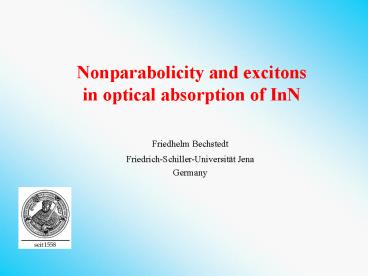PowerPointPrsentation - PowerPoint PPT Presentation
1 / 22
Title:
PowerPointPrsentation
Description:
Friedrich-Schiller-Universit t Jena. Germany. Optical absorption. 0. 2. 4. 6. 8. 10. 12. 14 ... a-plane on a-plane GaN/AlN. on r-plane sapphire (MBE) ... – PowerPoint PPT presentation
Number of Views:77
Avg rating:3.0/5.0
Title: PowerPointPrsentation
1
Nonparabolicity and excitons in optical
absorption of InN
Friedhelm Bechstedt Friedrich-Schiller-Universität
Jena Germany
2
Optical absorption
critical points
extraordinary (E c) ordinary (E ?
c) a-plane on a-plane GaN/AlN
on r-plane sapphire (MBE) R. Goldhahn et al.,
Superlattices Microstructures 36, 591 (2004)
E
6.05 eV
2
E
8.6 eV
4
E4.88 eV
E
7.87 eV
3
E
5.35 eV
1
onset
plateau
Photon Energy (eV)
3
Low-energy optical transitions
plateau
transition near 1.3 1.4 eV
onset (Eg 0.7 eV)
F. Bechstedt et al., phys. stat. sol. (a) 195,
628 (2003)
4
Onset (Gap)
(i) band calculation in DFT-LDA with and
without effects of d electrons
accuracy 0.1 eV (ii) extrapolated pd
repulsion accuracy 0.1 eV
(iii) quasiparticle gap opening
accuracy 0.1 0.1 0.2 eV
In4d screening Result Eg
(0.8 ? 0.4 ) eV
Other results All-electron self-consistent GW Eg
? 0 eV ( T. Kotani, SCC 121, 461 (2002)) Exact
exchange Eg ? 1.4 eV ( M. Städele, PRL 79, 2089
(1997))
5
Low-energy optical absorption
ordinary dielectric function
Spectral region below 4 eV ? dramatic effects due
to nonparabolicity of bands ? k?p theory
Kane model (cubic, h? gt Eg)
- plateau for h? gt Eg
- square-root for
- energy-dependent interband mass
- spectral ellipsometry R. Goldhahn et al.
- calculation (independent-quasiparticle approach)
- F. Bechstedt et al.
6
High-energy optical absorption
ordinary dielectric function
many peaks in 4 10 eV energy region trials to
relate to interband transitions
7
van Hove singularities
in principle impossible since several k-point
regions may contribute to one peak
D. Fritsch et al., PRB69, 165204 (2004)
8
Problem Excitons(more general electron-hole
interaction)
Electron-hole pair Hamiltonian
with quasiparticle energies
9
Independent-KS particles, independent
quasiparticles, and Coulomb-correlated
electron-hole pairs Optical absorption of Si
... quantitative agreement with experiment
Aspnes, Studna,
PRB27, 985 (1983)
W.G. Schmidt et al., PRB67, 085307 (2003)
10
Influence of excitons(example extraordinary
dielectric function)
- drastic effects
- broadening of electron-hole pairs,
- here 0.2 eV (smearing of fine
- structure due to density of states)
- red shift of high-energy
- transitions by 0.6 eV due to
- electron-hole attraction
- weak effect
- plateau uninfluenced
- advantages/disadvantages
- 6 ordinary / 3 extraordinary
- structures
Problems (i) convergence (4500 k points in BZ
not enough) (ii) lattice polarizability,
free-electron effect? (iii) pd repulsion
11
Optische anisotropy
- anisotropy intrinsic effect due to
- band structure
- absorption of light for h? lt 7 eV
- is weaker for ordinary polarization
- perpendicular to c axis (in
- agreement with measurements)
- drastic effect for peak around 5
- eV (exp. 5.35 eV) due to matrix
- elements
12
Summary / Conclusions
- characteristic lineshape (onset, plateau, peaks
due to band-to-band transitions) - versus increasing photon energy
- low-energy region
- high-energy region
- dominated by optical transitions around ? point
(upper valence bands into - first conduction band)
- onset plateau express nonparabolicity of
conduction band - weak excitonic effects
- dominated by optical transitions at k points in
several parts of the Brillouin - zone
- influence of excitons on peak positions and of
lifetimes on spectral structures
13
Collaborations/Acknowledgements
Computations J. Furthmüller L.K. Teles M.
Ferhat P. Hahn K. Seino
Experiments R. Goldhahn ... O. Ambacher ... C.F.
Mc Conville ... W.J. Schaff
Grants DFG German group-III nitride
initiative 1994 2002 EU RTN NANOPHASE 2001
04 NoE NANOQUANTA 2004 08
14
Dielectric function of InN
15
Optical anisotropy
a-plane InN on a-plane GaN/AlN on r-plane
Sapphire grown by MBE
(d670 nm, n6x1018 cm-3, ?250 cm2/Vs)
16
Parameterfree calculations of semiconductor gaps
two steps (i) ground-state calc. density
functional theory (DFT) local density
approximation (LDA) Kohn-Sham bands
??(k) (ii) excitation aspect XC
self-energy in GW, parturbation th.
quasiparticle shifts ??(k) ? gaps
with accuracy of 0.1 eV
KS gap QP effect QP gap AlN 3.9
1.9 5.8 eV GaN 2.3 1.2
3.5 eV
17
InN Why difficult?
(i) shallow In4d electrons (15 eV below VBM) ?
15 bonding ? overestimation of pd repulsion in
DFT-LDA/GGA negative ?1 - ?6
distance (ii) non-perturbative treatment of
quasiparticle effects to solve band gap problem
F. Bechstedt et al., J. Cryst. Growth 246, 315
(2002) phys. stat.
sol. (a) 195, 628 (2003)
18
Polarization anisotropy of absorption edge
- ? an intrinsic property of wurtzite InN and not
of metallic In inclusions - spin-orbit splitting clearly visible
- ? magnitude only for band-to-band transitions
R. Goldhahn et al., Superlattices
Microstructures 36, 591 (2004)
19
Level scheme near fundamental gap
F. Bechstedt in B. Gil, Low-dimensional nitride
semiconductors I. Vurgaftman/J.R. Meyer, JAP 34,
3675 (2003) B.E. Foutz et al., JAP 85, 7727 (1999)
20
Chemical trend in band structures
21
Optical transitions
22
Problem In4d electron
pd repulsion (Wei/Zunger (88))
Important In4d as valence electrons ?
correct lattice constant But 4d electrons too
shallow 13.5 eV (experimental 14.9 or
16.7eV) ? overestimation of pd
repulsion
Gaps and GW shifts (eV) Polytype LDA
LDA GW QP
QP (with 4d)
(without 4d) correction (with
4d) (without 4d) wurtzite
-0.19 0.58 0.93
0.74 1.50 zinc blende
-0.36 0.43 0.87
0.52 1.31
full
no
perturbation-theory argument for pd Eg 0.81
(0.59) eV wurtzite (zinc blende)
0.89 (0.67)































